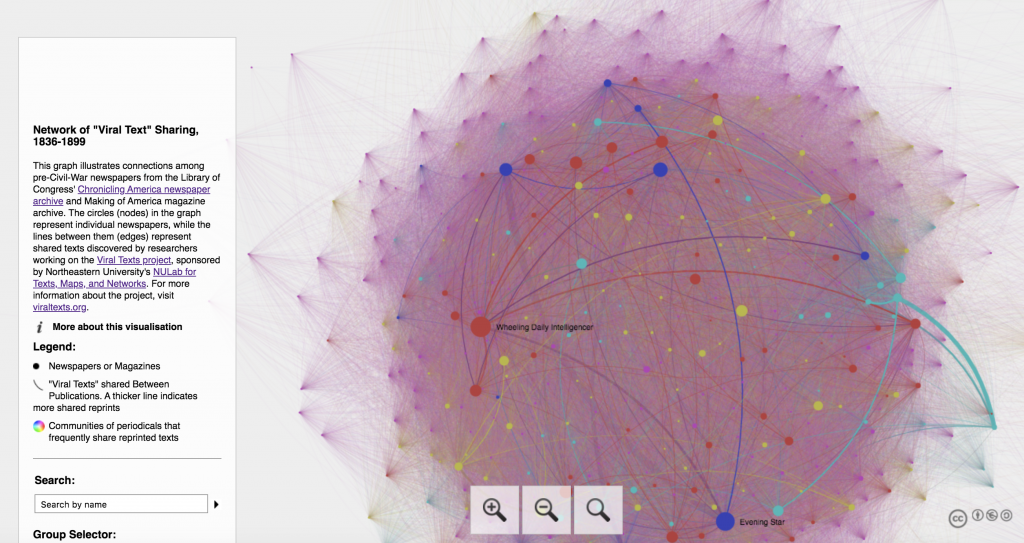Viral Texts is a website that consists of many different types of digital humanities projects including data, visualizations, network graphs, interactive exhibits, and computational and literary publications. Newspaper editors used to cut up other newspapers and paste together fictional stories, poems, news, jokes, and religious affirmations among other things. The goal of this website is to reveal the “textual and thematic” qualities of the newspapers that helped them “go viral” in the nineteenth century.
In reverse engineering Viral Texts, I found that there were many components that could individually be described as a digital humanities project, but they all were accumulated into this website. Viral Texts was very clear in its process and collaboration. On the home page, they described their goal and past iterations of the project, and they were very transparent in their funding and with their collaborators. They also had contact and maintenance information. These features are important to note, because (1) it helped me find the sources, processing data, and presenting information, and (2) it shows that this website is open-access and a well-made digital project, despite not being completed yet. The first aspect in reverse engineering a digital humanities project is finding the sources.
Sources
All digital humanities projects need to start with source information. In the case of Viral Texts, the team used newspapers from the Library of Congress’ Chronicling America newspaper archive and the Making of America magazine archive. Each archive had access to hundreds of newspapers. The creators then processed and analyzed the texts and types of stories in the newspapers.
Processing Sources
The Viral Texts website stated multiple times that they use the Northeastern University’s NULab for Texts, Maps, and Networks to process the sources. While they did not specify what technology they used, I can speculate that it includes some sort of text/document scanner, which then was processed into a spreadsheet including categorical variables such as keywords and types of stories, and quantitative variables such as the occurrence of certain words and stories. The team working on this project included annotations, metadata, transcriptions, and encoding when listing their methodology.
“Nothing but a newspaper can drop the same thought into a thousand minds at the same moment…”
Alexis de Tocqueville, Democracy in America
This quote, located on the home screen, might have been true in the nineteenth century, but as shown with this project, there are many other mediums in today’s world that can transmit ideas and thoughts. By presenting the data from these sources on the internet, the creators of this website can reach thousands or even millions of people in the same fashion.
Presenting Sources
The visual representations of the sources and their data are found on the website viraltexts.org which is a GitHub site using a beautiful-jekyll template (Ed by Alex Gil). The visuals themselves are a product of Northeastern University’s NULab for Texts, Maps, and Networks. This includes the networks graphs, interactive exhibits and collections of publications.

All visuals are available through a navigation system at the top of each page and hyperlinks. (Side note: many of the hyperlinks were broken and I could not get access to many pages of the website and, subsequently, much of the data and methodology. I believe this is part of their process, and will be fixed soon.) The presented material was visualized and organized well, and the purpose of the website was well-illustrated. By reverse engineering this website, I was able to find the sources, the methods of processing, and the presented visuals needed to create a digital project as complex as Viral Texts.